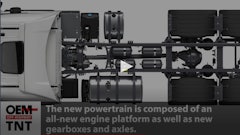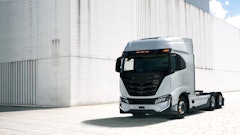
Fuel efficiency, driver comfort and safety are top priorities for customers in the heavy-duty trucking industry, and three of the key aspects OEMs are continually working to further develop. Over the past year, several manufacturers introduced new Class 8 trucks with features focused on improving the overall driver experience, as well as fuel efficiency.
Volvo Trucks North America’s new VNL Series long-haul truck, for instance, was designed around the driver. Refinement of various aspects—such as more ergonomic placement of vehicle controls and a larger cab interior—make it so the driver is the focal point of the vehicle, said Jason Spence, Product Manager for Long Haul at Volvo, during a launch event for the truck. 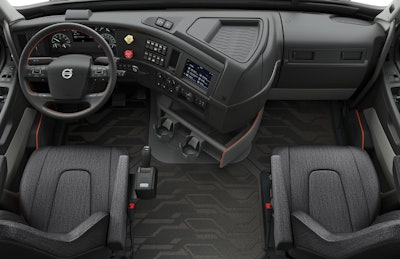 Volvo reconfigured the layout of vehicle controls in the new VNL to be more ergonomic, placing the most used controls closest to the driver.Volvo Trucks North America
Volvo reconfigured the layout of vehicle controls in the new VNL to be more ergonomic, placing the most used controls closest to the driver.Volvo Trucks North America
“A comfortable driver is a productive driver,” he said. “Comfort is imperative in design and the products we produce,” which is why Volvo placed such a large emphasis on redesigning the operator cab for the new VNL Series.
Comfort, and safety, are also important for driver retention. Roy Horton, Director of Product Strategy at Mack Trucks, said at a launch event for the new Mack Anthem that it costs a fleet $7,000 to recruit, train and onboard a driver. The industry also faces a greater than 75% driver turnover rate, and has been dealing with a driver shortage for several years now, making it critical for OEMs to design trucks that drivers actually want to drive.
A more comfortable driving experience
Driver comfort—in the long-haul truck market especially—is essential as operators spend several hours, and even days at a time, in their truck. Because of this, special attention is paid to the design of an operator cab when developing a new truck. One of the changes Volvo made was to offer a 70-in. (177.8 cm) sleeper configuration, the VNL 760. This cab is 9 in. (22.9 cm) longer and 6 in. (15.2 cm) wider than the previous VNL 670 model. A number of customization options are available for the sleeper so drivers can select the storage, appliances and other creature comforts which best fit their needs.
A strong emphasis was placed on reconfiguring the layout of vehicle controls to be more ergonomic; the most used switches that were once located on the dash are now on the steering wheel so that they are within easy reach of the driver’s thumbs. Not only does this aid comfort, but also improves safety by ensuring drivers keep their hands on the wheel and eyes on the road. Controls are also now a soft-touch design, further aiding comfort.
The gauge cluster was also redesigned to now include a 5-in. (12.7 cm) color display which provides driver information such as fuel economy and battery voltage. Drivers can configure the “home screen” of the display to show the information they prefer to see or would need to refer to most. Controls on the steering wheel are used to navigate through the various information screens, whereas Spence said in the past the controls were on the stall behind the steering wheel. “We brought them to the front because the interface the driver has today with the vehicle is much more than what it was 20 years ago,” he explains.
In 2018, Volvo will roll out a 7-in. color touchscreen infotainment option that will provide a combination of Apple CarPlay, navigation and rearview camera.
For its new Anthem long-haul truck introduced this past year, sister company Mack Trucks also put a strong emphasis on redesigning the operator environment. According to John Walsh, Mack Vice President of Global Marketing and Brand Management, the instrument panel has an intuitive design with automotive inspired controls, digital analog gauges and a 5-in. full color Mack Co-Pilot display. The Co-Pilot display provides vehicle information such as engine and oil temperatures, trip odometers, tire pressure and more.
The Mack Anthem features a flat bottom steering wheel, similar to that used in race cars, which provides easier vehicle ingress and egress as a driver’s legs are better able to slide under it. The steering wheel can be upgraded to include controls for cruise control, Bluetooth and infotainment features.
To put more controls at the drivers’ fingertips, the stocks at the steering wheel were redesigned to include often-used controls; the right stock manages the engine brake and Co-Pilot display while the left controls high beams, turn signals and wipers.
Mack partnered with Sears Seating to develop as comfortable a seat as possible for the Anthem. Stu Russoli, Highway Product Manager at Mack Trucks, said at the truck’s launch event that the companies went through a number of variations before landing on the final seat design, having drivers test the different iterations throughout the development process to ensure it would meet their comfort needs. Various style and function configurations—30 in total—are available for the seat to optimize it for individual customer needs.
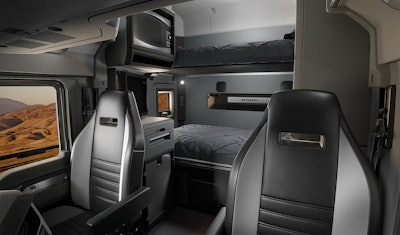 The sleeper portion of Mack's new Anthem truck can be configured in various ways to suit drivers' preferences, such as with a double bunk.Mack Trucks Inc.
The sleeper portion of Mack's new Anthem truck can be configured in various ways to suit drivers' preferences, such as with a double bunk.Mack Trucks Inc.
Once in the sleeper, a driver will find 35% more space, which can be configured with up to 27 cu. ft. (0.7 m) of storage—enough to store about 19,000 golf balls, said Walsh. Similar to the Volvo VNL, a variety of configurations for the bunk, storage and other amenities are possible within the Anthem.
Like the new Volvo and Mack trucks, International’s newly updated LoneStar truck features vehicle controls which have been reconfigured for easier accessibility. The instrument cluster has been updated with new graphics and a new overall design, with multiple gauges which are selectable to customize the information to the driver’s preference.
Buttons on the steering wheel for various vehicle controls use commonly understood ISO symbols to indicate the functions they perform. The symbols are laser etched to minimize wear, while backlighting helps provide visibility at night. Rocker switches were also updated with laser etching and backlighting, as well as made large enough to use with a gloved hand.
A new shifter mounted on the steering column enables easy accessibility to shifting operations, said David Majors, Vice President of Product Development at Navistar Intl., during a presentation on the new truck. This allows drivers to keep their eyes on the road and hands on the wheel to ensure safety.
For the use of Bluetooth within the truck, a pillar-mounted microphone was added. Majors said that a significant amount of time was spent on the placement of this microphone to ensure it was in the best possible position to eliminate feedback or road noise, and enable the driver to speak at normal levels.
Design time was also spent on ingress and egress of the vehicle with the cab door opening 4 degrees wider, and the steps placed in a more sensible manner. Majors said three points of contact were added, as well, to ensure drivers’ safety when entering and exiting the vehicle.
Improving the overall design of the cab door was a focus for Navistar, said Majors, particularly in regards to NVH (noise, vibration and harshness). The door structure is two times stiffer and features more steel compression to improve NVH. Noise from outside the cab is virtually eliminated. “You [can] hold a conversation going down the road 60/65 mph (96.6/104.6 kph) with no exterior noise, no wind noise,” explained Majors. “A lower NVH level in the vehicle helps improve driver fatigue over the long haul.”
Increasing safety
Visibility from the driver’s seat is an important factor when it comes to operator comfort, as well as safety. Majors said the updated design of the International LoneStar truck makes it so drivers have to turn their head 15% less to the left, and 5% less to the right. They are also able to see 20 in. (50.8 cm) closer to the truck when looking out the driver’s side window.  The updated International LoneStar is available with a Cummins X15 engine, providing a 3% fuel efficiency improvement. A more aerodynamic design to the truck also aids efficiency.Navistar International Corp.
The updated International LoneStar is available with a Cummins X15 engine, providing a 3% fuel efficiency improvement. A more aerodynamic design to the truck also aids efficiency.Navistar International Corp.
The truck’s pedestal mirrors have been pushed slightly forward to improve visibility; Majors said the mirrors’ new placement helps reduce driver neck strain by about 12%. They also feature a lightweight design to save about 7 lbs. (3.2 kg) of weight, which he said equates to about half a percent better fuel economy.
“One of the comments we got back from the drivers [is that] the new windows and placement of the pedestal mirrors gives the feel of a larger, more spacious cab environment, which again helps the driver day-to-day operations,” he said.
New hood mirrors on the Mack Anthem improve visibility by expanding the field of view and reducing blind spots, and are aerodynamically designed to reduce drag. Russoli said the mirrors sit up high, with the right-hand mirror positioned way out so that drivers can see down the whole length of the trailer. It is also positioned in line with the side mirror to ensure good aerodynamics by cutting through the wind only one time.
Lighting is an integral part of ensuring driver visibility. Use of LEDs has become more common within the industry. Walsh said the new Anthem has all LED lights—everything from the headlights and turn signals to the marker lights and taillights. Its LED headlamps are 66% brighter than incandescent versions, he said, ensuring visibility of the road ahead. LEDs also offer the benefit of drawing less power and creating a whiter light which causes less eye strain for drivers.
The Volvo VNL also includes all LED lights. Its headlamps are capable of defrosting themselves in colder weather by using the heat generated by the LEDs. A fan draws heat out of the lamp during normal weather conditions, but can reverse its flow to keep heat in the lamp to defrost the surface, ensuring optimal visibility in adverse weather conditions.
Spence said the company put a lot of money into active safety systems on the truck. “That’s where customers save the most money, and that’s where we’ve put most of our investment,” he said.
“The cheapest crash is the one that never happened,” said Rob Simpson, Brand Development Director for Volvo Trucks. “So helping our customer avoid those crashes to begin with is where they will realize the greatest savings.”  Volvo Active Driver Assist monitors vehicles in front of the truck and warns drivers of an impending collision with audible and visual alerts.Volvo Trucks North America
Volvo Active Driver Assist monitors vehicles in front of the truck and warns drivers of an impending collision with audible and visual alerts.Volvo Trucks North America
Based on federal data, he said the average cost of a commercial vehicle crash is $110,000. The average truck has 2.2 crashes per million miles, which equates to about $240,000 per million miles. And with trucks typically traveling 100,000 miles per year, Simpson said the annual cost of crashes per truck is about $24,000. “We also know front-end collisions represent 31% of all commercial vehicle crashes. Thirty one percent of that $24,000 is $7,500.
“Reduce that by 80% [and] you’re saving $6,000 per truck per year, or reducing crash costs about 25%,” he said.
“Active safety starts with visibility,” said Spence. Because of this, the truck’s designers curved the hood down and carved more out of the side of the hood to improve visibility over the top and sides. Volvo also included a puddle lamp on the bottom of the door panel to illuminate the steps and ground for safer entry and exit of the truck.
Warning drivers sooner about the potential of a collision benefits safety, as well. Giving drivers just 1 second more of a warning can reduce the risk of a collision 90%, Stenson said. To aid drivers with collision avoidance, Volvo’s Active Driver Assist technology will now come standard on the VNL Series trucks. The system consists of Bendix Wingman Fusion, a camera- and radar-based collision mitigation system, fully integrated into Volvo’s Driver Information Display.
The camera and radar continually monitor objects and their position in relation to the truck, helping drivers maintain a safe following distance. “But when those conditions change, the driver can be alerted,” said Simpson. By having a fully integrated system, he said the system can send warnings to drivers to let them know when they’re getting too close to vehicles ahead.
All alerts from the system are placed in front of the driver, unlike other systems which often have warnings that come from a driver’s periphery. “That can actually cause distractions and make the driver turn away from the road,” explained Simpson. “We’re putting everything right in front of the driver. [Because we] know its safest when drivers’ hands are on the wheel and they’re looking ahead.”
If a driver does not take corrective active after receiving the initial alerts from the system, Volvo has added a new heads up warning that flashes a red light reflected in the windshield, right in front of the driver. And if corrective action still isn’t taken, Simpson said Volvo Active Driver Assist will step in by reducing throttle, disengaging cruise and applying up to two-thirds braking force to slow or stop the vehicle in order to reduce impact or prevent a collision altogether.
“Studies have shown that this technology can reduce front-end collisions by 80%,” said Simpson. “We think this is an incredibly valuable tool for our customers.
“We will not stop until we achieve [our] vision of zero accidents,” he added.
Read more about this type of safety system in the article “A More Accurate Picture of Vehicle Surroundings.”
Passive systems are also an integral part of ensuring driver safety. “Passive safety is about protecting drivers in the event of a crash,” explained Simpson. As such, the company has developed a high-strength steel cab for the VNL which exceeds both the Volvo Swedish Cab Safety Test and ECE R-29 rollover requirements. In addition, one of the seat options is a RollTek seat featuring a side-roll airbag protection system. Simpson said that when a sensor integrated into the seat detects the vehicle is starting to roll, three actions are initiated within 0.25 seconds—the seatbelt tensions to hold the driver still in the seat; the seat’s air suspension drops to create more survivable space overhead; and the side-impact airbag deploys to provide cushioning for the driver’s head and neck.
In the event of a collision, the splayed rails of Volvo’s VNL spread with the powertrain dropping to the ground in order to take energy away from the driver’s body. “Everything you can do to take the energy away improves survivability,” said Spence.
The shape of efficiency
Fuel efficiency is an important aspect of truck design, as well, as fuel costs are a large part of overall operating costs for fleets. “Because fuel efficiency is so important, the design of the truck is important,” said Spence.
He said the Volvo VNL would be even more fuel efficient than it currently is if it looked like a bullet train. “But our designers wouldn’t have a job because a bullet train is not attractive…it’s hard to be passionate about that kind of design.” The VNL is a compromise between a bullet train and a real truck, he said.
Starting at the front of the truck, the bumper is 1-1/2 in. (3.81 cm) farther forward than the previous version to aid aerodynamics. It has a better sweep angle, said Spence, and is pulled in at the corners for better air transition from the front of the vehicle to the sides.
Chassis fairings are lower to the ground to prevent crosswind, and thus improve aerodynamics. In addition, Spence said the hood is designed so that engine air intakes are farther forward. “This gets cleaner air into the engine, [as well as] gives a better line for airflow down the side of the vehicle,” he explained.
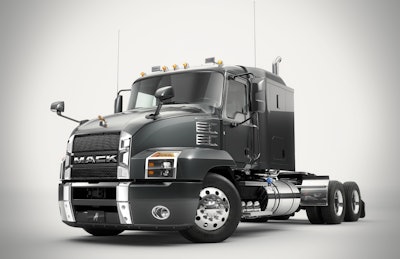 New hood mirrors on the Mack Anthem improve visibility by expanding the field of view and reducing blind spots, and are aerodynamically designed to reduce dragMack Trucks Inc.
New hood mirrors on the Mack Anthem improve visibility by expanding the field of view and reducing blind spots, and are aerodynamically designed to reduce dragMack Trucks Inc.
Russoli added that the flat fenders and chiseled corners of the truck’s design were kept to be reminiscent of the company’s heritage, while the slope of the hood features a different contour from past designs. Just before the windshield, the hood slants up to direct wind up and over the cab and the trailer to improve aerodynamics. The fenders sweep back on the sides, he said, to get even airflow around the sides of the trailer without turbulence.
Between the bumper and the hood on both sides of the Anthem is a rubber closeout flange which prevents air from entering the wheel well and causing air turbulence. “By moving the air around the side instead of allowing it through, we get better aerodynamics,” explained Russoli. An optional air dam on the bottom of the bumper helps control under-cab airflow.
While the shape of a truck is important, it’s not the only factor to take into consideration when improving fuel efficiency. Spence said aerodynamics only attribute for 1% of the fuel efficiency improvement of the Volvo VNL. “The rest is the powertrain.”
The truck comes standard with the company’s D13 engine, featuring a one-box aftreatment system—which helps save weight, and thus reduces fuel use—and is paired with the I-shift automated manual transmission (AMT) with crawler gears. It also includes Volvo’s patented wave pistons which help to burn fuel efficiently.
The VNL is available with a D13 Turbo Compound (D13 TC) engine, as well, featuring a mechanical waste heat recovery system to capture wasted energy from the engine’s exhaust. Volvo says this results in an additional 50 hp (37.3 kW) being fed back to the crankshaft and fuel efficiency improvement of up to 6.5%.
Inclusion of Volvo I-See predictive cruise on the VNL can add an additional 1/2-3% fuel efficiency improvement, said Russoli. Volvo I-See records route topography and works in tandem with the AMT to choose the optimal gear for the road ahead. The terrain being traveled will determine the potential fuel savings; hilly, mountainous roadways will provide more opportunity for savings, said Russoli, than a flatter route.
Scott Barraclough, Technology Product Manager at Mack Trucks, said that integration is key to achieving efficiency goals, and that components which are designed from the start to work together typically work better. The company designs its own transmissions, engines and axles, and designs them to work together as a system.
Mack’s integrated powertrain on the new Anthem includes the MP8 engine which also features a wave piston design and turbocompounding; it is capable of achieving up to an 8.8% fuel efficiency improvement compared to a standard engine with the same horsepower. Use of the Mack ClearTech One single unit aftreatment system saves space and 17 lbs. of weight, further aiding fuel efficiency.
The integrated powertrain also includes Mack dual-reduction rear axles that Barraclough said have a gearing design which is more efficient than single reduction designs, and works with rest of the powertrain to improve overall efficiency.
For its new LoneStar truck, International is offering the Cummins X15 which helps improve fuel efficiency 3%. Majors said it features a lightweight and compact design, as well as a single canister aftertreatment system to save over 100 lbs. (45.4 kg) of weight compared to previous systems.
How a driver operates a vehicle also factors into the fuel efficiency improvements that can be achieved. Spence concluded that customer education is important to ensuring optimal efficiency, both in how best to operate the truck and what features or options are available to help maximize fuel use.
Similarly, when it comes to safety, nothing can take the place of a safe driver, but with the growing enhancements to safety systems and visibility, as well as driver comfort, manufacturers are helping make trucks and roadways safer working environments.







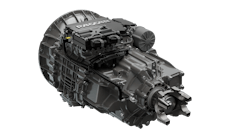









![Ed3 Onboard Charger Promotional Image[1]](https://img.oemoffhighway.com/files/base/acbm/ooh/image/2023/11/ED3_onboard_charger_promotional_image_1_.65579b42d5e0d.png?auto=format%2Ccompress&fit=crop&h=135&q=70&w=240)
![Freightliner4[1]](https://img.oemoffhighway.com/files/base/acbm/ooh/image/2023/10/Freightliner4_1_.653bd134621e1.png?auto=format%2Ccompress&fit=crop&h=135&q=70&w=240)





![Charlotte Ebus 2e[20]](https://img.oemoffhighway.com/files/base/acbm/ooh/image/2022/01/Charlotte_Ebus_2e_20_.61f3068676a88.png?auto=format%2Ccompress&fit=crop&h=135&q=70&rect=0%2C231%2C1920%2C1080&w=240)
